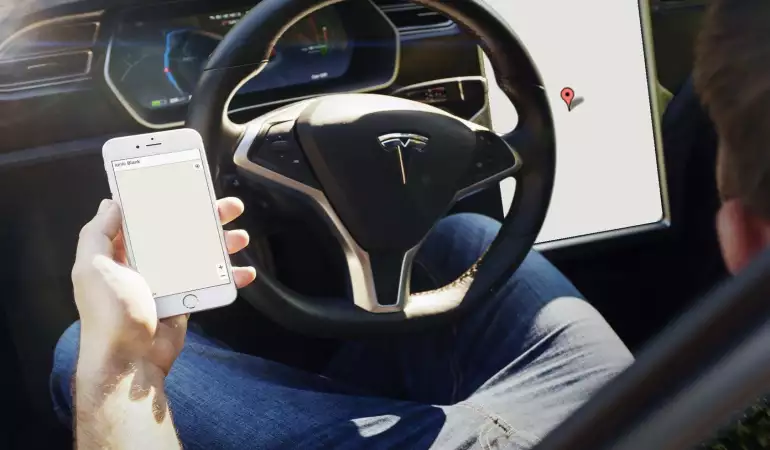How to Fix Blank Google Maps on Android and Chrome
This problem generally happens when you have too many bugged cookies in your browser or cached data in your Android app. The best solution to blank Google Maps is getting rid of the unwanted data from your mobile app or web browser.
August 07, 2023 00:57
In today's tech-driven world, a familiar frustration among Android and Chrome users is the sudden appearance of blank screens while using Google Maps. This perplexing phenomenon can lead to inconvenience and confusion, disrupting the seamless experience that users expect from this essential navigation tool.
Google Maps has evolved into much more than just a digital map. It serves as a cornerstone for navigation, location-based services, and real-time traffic updates. From finding the quickest route to a destination to discovering nearby points of interest, the application has become integral to our daily lives. The reliance on Google Maps underscores the significance of addressing the blank screen issue promptly, ensuring uninterrupted access to its invaluable features.
Understanding the Issue
When users encounter the blank Google Maps issue, it can be an incredibly frustrating experience that disrupts their navigation and location-based activities. Several factors could contribute to this problem, ranging from cache complications to network disruptions and even software glitches. Understanding these potential reasons is essential to effectively address the issue and provide users with a solution that alleviates their frustration.
A. Possible Reasons Behind the Blank Google Maps Issue
1. Cache Problems: Cached data allows Google Maps to load faster by storing previously accessed information. However, corrupted or outdated cache files can lead to conflicts that prevent the maps from displaying correctly. When cache files are damaged, users might encounter a blank map screen due to the failure in retrieving and rendering map data.
2. Network Issues: Seamless functionality of Google Maps heavily relies on a stable internet connection. Slow or intermittent connectivity, or even complete network outages, can hinder the application's ability to fetch map data in real-time. In such cases, users might find themselves facing a blank map as the application struggles to load the required information.
3. Software Glitches: Like any complex software, Google Maps can occasionally experience glitches and bugs that disrupt its normal operations. These glitches might interfere with the process of loading map data, causing a blank screen to appear. These software-related issues can arise from compatibility problems, recent updates, or unexpected interactions with other applications on the device.
B. Frustration Experienced by Users
Encountering the blank Google Maps issue can evoke a sense of frustration and helplessness among users who rely on the application for navigation, exploration, and location-based services. This frustration is compounded by the fact that Google Maps has become an integral part of modern life, aiding in daily commutes, travel planning, and discovering new places. When the app fails to function as expected, users may experience inconvenience, delays, and a lack of confidence in their ability to reach their destinations accurately.
In addition, the sudden disruption of Google Maps' functionality due to a blank screen can be especially exasperating when users are in unfamiliar areas or time-sensitive situations. The inability to view maps not only impacts navigation but also hinders users' ability to make informed decisions about their surroundings, leading to increased stress and anxiety.
Given the widespread reliance on Google Maps, addressing the blank map issue promptly and effectively is essential to restoring users' confidence in the application and ensuring smooth navigation experiences. By understanding the underlying reasons for this issue and acknowledging the frustration it causes, developers and support teams can work towards comprehensive solutions that enhance the overall usability and reliability of Google Maps.
Fix Blank Google Maps On AndroidA. Clearing Cache and Data
When you encounter issues with the Google Maps app on your Android device, one of the first troubleshooting steps is to clear the cache and data. Cached files can sometimes become corrupted or outdated, causing performance problems. Follow these steps to clear cache and data for the Google Maps app:
1. Open your device's Settings.
2. Scroll down and select Apps or Apps & notifications, depending on your Android version.
3. Locate and tap on Google Maps from the list of installed apps.
4. Select Storage & cache or similar options.
You'll see options to clear cache and clear data. Start with clearing the cache, and if the issue persists, you can proceed to clear data. Keep in mind that clearing data will reset app settings, so you might need to sign in again.
B. Checking Permissions
Google Maps requires certain permissions to function properly, especially location and storage access. To ensure the app has the necessary permissions:
1. Open your device's Settings.
2. Scroll down and select Apps or Apps & notifications.
3. Find and tap on Google Maps.
4. Choose Permissions.
5. Make sure Location and Storage permissions are enabled. If not, toggle them on.
C. Updating the App
Outdated app versions can lead to compatibility issues and bugs. Follow these steps to update Google Maps:
1. Open the Google Play Store app.
2. Tap the three horizontal lines (hamburger menu) in the top-left corner.
3. Select My apps & games.
4. You'll see a list of apps with available updates. Find Google Maps and tap Update.
D. Checking Network Connections
Issues with network connections can affect the functionality of Google Maps. Here are tips to troubleshoot connectivity problems:
For Wi-Fi issues:
1. Make sure you're connected to a stable Wi-Fi network.
2. Restart your router if needed.
3. Check if other devices can connect to the Wi-Fi.
For mobile data issues:
1. Ensure mobile data is turned on.
2. Try toggling Airplane mode on and off.
3. Reset network settings if necessary (found in your device's network settings).
E. Disabling Battery Saver Mode
Battery saver mode can limit app performance to conserve power. To disable it for improved Google Maps functionality:
1. Open your device's Settings.
2. Scroll down and select Battery or Battery saver.
3. If battery saver mode is enabled, toggle it off.
Remember, if the issues persist after trying these troubleshooting steps, you might want to consider reinstalling the Google Maps app as a last resort.
Troubleshooting Steps for Chrome
When encountering issues with Google Chrome's performance, functionality, or overall browsing experience, following a systematic troubleshooting approach can often help identify and resolve the underlying problems. The following sections outline a series of steps you can take to troubleshoot and address common issues.
A. Clearing Browser Cache and Cookies
Over time, cached data and cookies can accumulate in Chrome, potentially leading to various problems such as slow loading times, display glitches, and login issues. Clearing your browser's cache and cookies can often resolve these issues. To do this, follow these step-by-step instructions:
1. Click on the three-dot menu icon located at the top-right corner of the browser window.
2. Select "Settings" from the dropdown menu.
3. Scroll down and click on "Privacy and security" in the left-hand sidebar.
4. Under the "Privacy and security" section, click on "Clear browsing data."
5. Choose a time range for which you want to clear the data. Select "All time" to clear all cached data and cookies.
6. Make sure "Cached images and files" and "Cookies and other site data" options are checked.
7. Click on the "Clear data" button to initiate the clearing process.
8. Once the process is complete, restart Chrome and check if the issue persists.
B. Disabling Extensions
Extensions can greatly enhance your browsing experience, but they can also be a source of conflicts that lead to issues. If you suspect that one or more extensions might be causing problems, consider disabling them temporarily to see if the issue is resolved. Here's how you can do it:
1. Click on the three-dot menu icon and go to "More tools."
2. Select "Extensions" from the submenu.
3. On the Extensions page, you'll see a list of all installed extensions.
4. Toggle off the switch next to each extension to disable them.
5. After disabling the extensions, restart Chrome and check if the problem is resolved. If it is, you can enable the extensions one by one to identify the problematic one.
C. Updating Chrome
Keeping your browser up to date is crucial for optimal performance and security. Updates often include bug fixes, performance improvements, and new features. Here's why updating Chrome is important:
1. Improved Performance: Updates can enhance the browser's speed and responsiveness.
2. Security Patches: Updates fix known vulnerabilities, protecting you from potential threats.
3. Compatibility: New updates ensure compatibility with the latest web technologies.
To update Chrome:
1. Click on the three-dot menu icon and go to "Settings."
2. In the left-hand sidebar, click on "About Chrome."
3. Chrome will automatically check for updates and install them if available.
4. After the update is complete, relaunch Chrome to apply the changes.
D. Resetting Chrome Settings
If you're facing persistent issues that seem related to your browser's configuration, resetting Chrome settings to their default state can help. This process can resolve problems arising from incorrect settings or configuration changes. Follow these steps to reset Chrome settings:
1. Open Chrome's settings and scroll down to "Advanced."
2. Under the "Reset and clean up" section, click on "Restore settings to their original defaults."
3. Click "Reset settings" in the confirmation popup.
4. Remember that this action will reset your homepage, search engine, and pinned tabs, among other settings.
E. Checking Security Software
Security software, such as antivirus programs and firewalls, can sometimes interfere with Chrome's functionality. If you suspect that security software is causing issues, follow these steps:
1. Temporarily disable your security software and firewall.
2. Restart Chrome and check if the problem persists.
3. If the issue is resolved after disabling the software, you may need to adjust its settings to allow Chrome to function properly.
4. If necessary, consult your security software's documentation or support for guidance on configuring it to work seamlessly with Chrome.
By systematically following these troubleshooting steps, you can often identify and resolve common issues with Google Chrome, ensuring a smoother and more enjoyable browsing experience.
Additional Tips
In addition to the troubleshooting steps mentioned earlier, there are a few additional tips that can help you address any lingering issues with Google Maps.
A. Restart Your Device
After applying any troubleshooting steps, it's a good practice to restart your device. Sometimes, minor glitches can be resolved by simply restarting your smartphone or tablet. This action can help refresh the system and clear any temporary cache that might be causing conflicts.
B. Report the Issue to Google
If you find that the problem persists despite trying the troubleshooting steps, don't hesitate to report the issue to Google's support team. They have dedicated resources to address user concerns and can provide tailored assistance based on the specific problem you're encountering. Reporting the issue not only helps you get closer to a resolution but also contributes to the overall improvement of the Google Maps experience.
C. Explore Google Maps Alternatives Temporarily
While Google Maps is a widely-used and reliable navigation tool, there are times when temporary issues might impact its functionality. During such instances, consider exploring alternative mapping and navigation apps available on the market. Many reputable alternatives offer similar features and can provide a seamless navigation experience. This can be particularly useful when you need to get to your destination without any hiccups while Google resolves the issue.
By keeping these additional tips in mind, you can ensure a smoother experience while using Google Maps and navigate through any challenges that may arise. Remember that technology can sometimes be unpredictable, but with the right approach, you can overcome hurdles and make the most of your navigation needs.
Conclusion
In conclusion, the timely resolution of the blank Google Maps issue is of paramount importance. This issue not only disrupts the user experience but also hampers the efficiency and convenience that Google Maps provides for navigation and location-based services. With the reliance on digital maps growing exponentially in both personal and professional spheres, the inability to access Google Maps on Android and Chrome can significantly impact daily activities, travel, and business operations.
To ensure a seamless and hassle-free experience, we strongly encourage all users facing this issue to follow the troubleshooting steps provided in this guide. By diligently addressing the potential causes and applying the recommended solutions, users can regain access to the invaluable features that Google Maps offers. Whether it's for getting accurate directions, exploring new places, or planning routes efficiently, reinstating the functionality of Google Maps can greatly enhance both productivity and peace of mind.
Remember, technology hiccups are not uncommon, but with the right guidance, they can be overcome swiftly. By taking action and implementing the troubleshooting steps outlined here, you can once again harness the power of Google Maps to navigate the world around you with confidence and ease. Stay connected, stay informed, and make the most of the incredible tools at your disposal.











